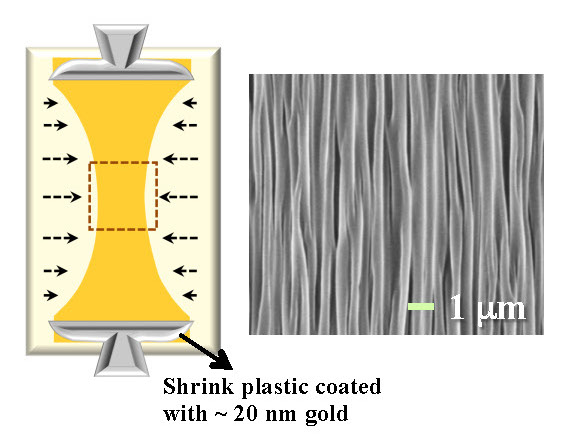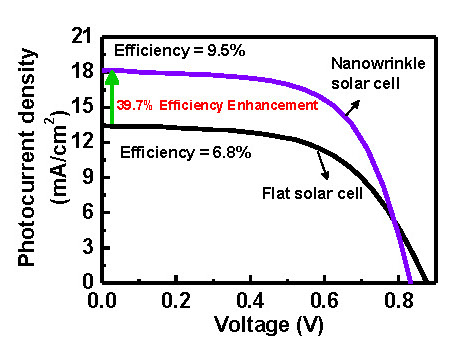New solar cell technology based on a toy
Solar cells are expensive and difficult to mount and maintain, putting researchers always on the alert for new ways of producing them. A team of researchers based at the Department of Physics and Astronomy and iNano at Aarhus University went to the toyshop and found something that may cause a major break-through.

Shrinking plastic sheets are what makes it almost impossible to get into your lunch packet or your new electronic gadget, and in toyshops you can buy clear flat sheets of the material that will shrink when heated. Amongst other things it is used by kids and artists to paint on, because the colours become much more intense after heating and shrinking. One of the brands are "Skrinky Dinks". Sanjay Ram et al. has just published a paper in the respected periodical Nano Energy describing the use of this material for making a base layer in a new type of solar cells. The results stem from the project THINC, an international research effort financed by the Innovationsfonden and led by Aarhus University professor Peter Balling. In the paper are also inputs from the group led by Rita Rizzoli at IMM, Bologna and Rui N. Pereira's group at the Aveiro University, Portugal.
The Method
Take a sheet of clear shrinking plastic, deposit a thin layer of gold on it and mount it in a frame that allows the sheet to shrink in only one dimension. After warming the sheet you will get an oblong sheet with a pattern of tiny parallel nano-size wrinkles on the surface. From there on there is a rather tedious length of processes before you end up with the finished solar cell. The result is a cell so thin that it can be shaped over a surface, it can be produced in long sheets and it is cheap and durable. The new cell type is not quite as energy efficient as traditional types, but the cost will be much lower that ordinary silicon cells, and mounting will be much easier. But wait before you plan on visiting the DYI market to buy a roll! In a smaller lab-scale environment, the process is relatively easy, but it will be a couple of years before this new type of solar cells will be available in long sheets or rolls.
As mentioned you start by depositing a very thin layer of gold on the plastic sheet. The thickness of the layer, e.g. 20 nanometer (1/5000 millimeter) will decide the depth and width of the nano-wrinkles. After shrinking the gold is cleaned away with an aqua-regia solution, and the wrinkled sheet of plastic is cleaned.
Next a cast is made of the wrinkled surface and from this a new plate is produced in a UV-hardening glass-polymer, a bit like what you might experience when going to the dentists.
On this glass-polymer various materials are layered on top of each other. Some are conducting, one in between is the current producing silicon layer and on top is a layer of protection. The result is a solar cell only 1/1200 mm thick in total and pliable.
The usual ones
An ordinary solar cell is produced from a thin slice of silicon, cut from a larger silicon crystal. On this sheet is mounted a network of electrodes and a thin layer of glass on top for environmental protection. Sunlight reaching the silicon layer will deposit its energy and be attenuated on the way down through the layer, in a way that only light below a certain wavelength, mainly purple and blue light, will be absorbed. Red light needs to pass through a thicker layer in order to be absorbed. The glass layer makes the cell heavy and the silicon disk is expensive and difficult to produce, and it can only be produced up to rather limited dimensions, - the squares or disks that you typically see on a solar cell panel.
 What's the trick?
What's the trick?
The nano-wrinkeled solar cell has a layer of silicon thin enough to let sunlight through and be reflected on the wrinkeled layer. Because the wrinkles are not totally regular, the light will be reflected at different angles, enabling the light to pass through a longer path inside the silicon. This means that the various wavelengths can be utilized more efficiently. Red light especially needs to pass through a thick layer because its absorption length in silicon is relatively longer. The wrinkles will also enable the solar cell to work more efficiently i situations where sunlight is not exactly perpendidular to the solar cell sheet. Fixed panels mounted on roofs will be more efficient because they will be able to absorb more of the Suns rays during morning and afternoon, especially in Winter and in extreme Northern or Southern latitudes.

The original cast of the Skrinky Dink sheet is hard enough to be used several times as a cast, so you don't have to deposit new layers of gold on new pieces of plastic all the time. Using a cast with just the right pattern of wrinkles and reusing this will of course also help making the process of production easier and less expensive.
The paper is titeled: "Efficient light-trapping with quasi-periodic uniaxial nanowrinkles for thin-film silicon solar cells". It was published in Nano Energy 35:341 in April 2017.
